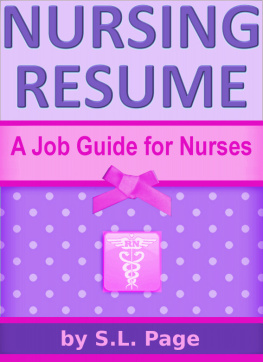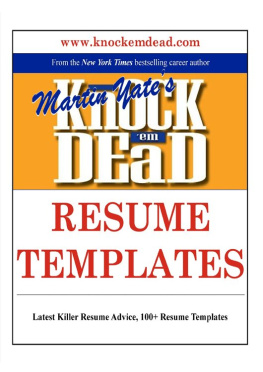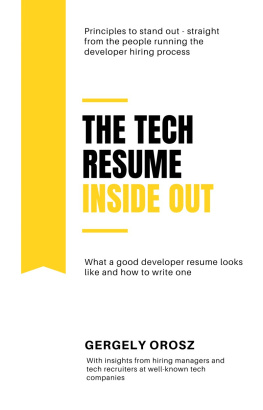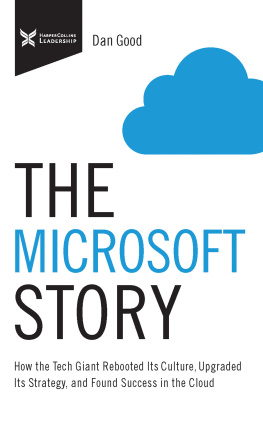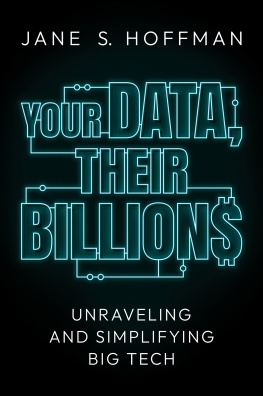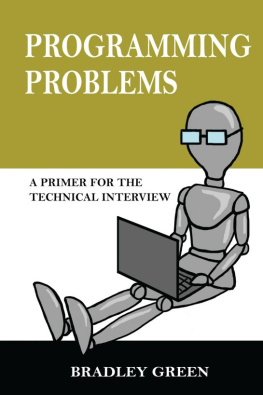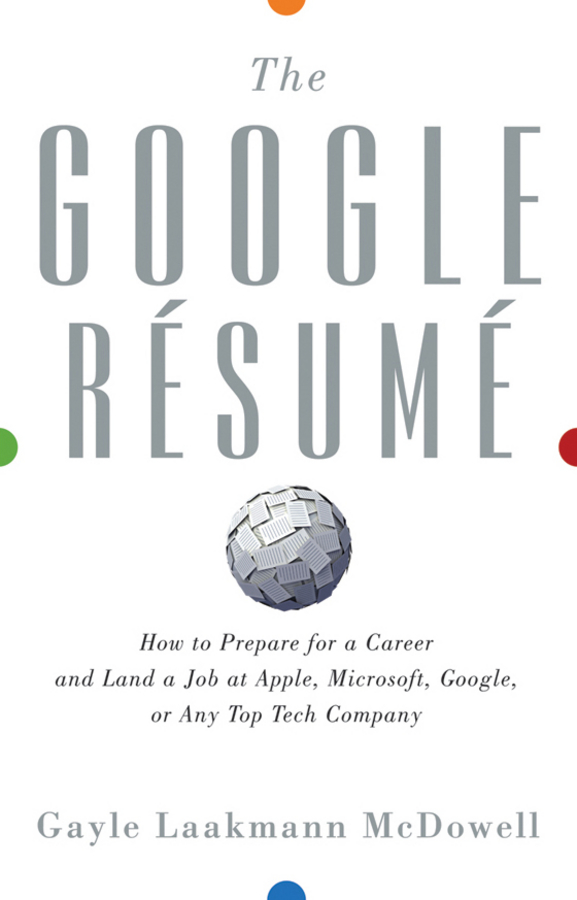Contents

Copyright 2011 by Gayle Laakmann. All rights reserved.
Published by John Wiley & Sons, Inc., Hoboken, New Jersey.
Published simultaneously in Canada.
No part of this publication may be reproduced, stored in a retrieval system, or transmitted in any form or by any means, electronic, mechanical, photocopying, recording, scanning, or otherwise, except as permitted under Section 107 or 108 of the 1976 United States Copyright Act, without either the prior written permission of the Publisher, or authorization through payment of the appropriate per-copy fee to the Copyright Clearance Center, Inc., 222 Rosewood Drive, Danvers, MA 01923, (978) 750-8400, fax (978) 646-8600, or on the web at www.copyright.com . Requests to the Publisher for permission should be addressed to the Permissions Department, John Wiley & Sons, Inc., 111 River Street, Hoboken, NJ 07030, (201) 748-6011, fax (201) 748-6008, or online at http://www.wiley.com/go/permissions .
Limit of Liability/Disclaimer of Warranty: While the publisher and author have used their best efforts in preparing this book, they make no representations or warranties with respect to the accuracy or completeness of the contents of this book and specifically disclaim any implied warranties of merchantability or fitness for a particular purpose. No warranty may be created or extended by sales representatives or written sales materials. The advice and strategies contained herein may not be suitable for your situation. You should consult with a professional where appropriate. Neither the publisher nor author shall be liable for any loss of profit or any other commercial damages, including but not limited to special, incidental, consequential, or other damages.
For general information on our other products and services or for technical support, please contact our Customer Care Department within the United States at (800) 762-2974, outside the United States at (317) 572-3993 or fax (317) 572-4002.
Wiley also publishes its books in a variety of electronic formats. Some content that appears in print may not be available in electronic books. For more information about Wiley products, visit our web site at www.wiley.com .
Library of Congress Cataloging-in-Publication Data:
McDowell, Gayle Laakmann, 1982
The google rsum : how to prepare for a career and land a job at Apple, Microsoft, Google, or any top tech company / Gayle Laakmann McDowell.
p. cm.
Includes index.
ISBN 978-0-470-92762-5 (hardback)
ISBN 978-1-118-01313-7 (ebk)
ISBN 978-1-118-01314-4 (ebk)
ISBN 978-1-118-01315-1 (ebk)
1. Rsums (Employment) 2. High technology industriesVocational guidance. 3. Job hunting. I. Title.
HF5383.M335 2011
650.14'2dc22
2010039906
To my mother and grandmother, whose engineering endeavors paved the way for my own.
Chapter 1
Introduction
Just so youre clear: it was not my idea to give a talk to Microsoft Research. I had learned embarrassingly little about computer science in my 18 years of life, and the last thing I wanted to do is to have that exposed in front of a bunch of genius PhDs in MSR. But my manager thought itd be a great opportunity, and so there I was, blabbing on about my summer project.
I finished up my talk at lightning speed. As I was dealing with a somewhat severe case of stage fright, I considered my haste a good thing. And then the questions started. Did I consider doing X? Yes, I told them, I did, and this is what happened. Why not implement it with Y? You could, but that would cause problem Z.
I almost hesitated to admit it to myself afterwards, but things went fine. Just fine.
That whole summer I had been convinced that Microsoft would discover that I knew practically nothing and cut me loose. I had only gotten my internship offer through some brilliant streak of luck, I reasoned, and didnt really deserve it. Not like my fellow interns did anyway. They had done three times as much college as me, completed three times as many projects, and basically knew three times as much as me.
Four years later, with a job at Google about to start, I reflected on my incredible luck. I landed a Microsoft internship at an incredibly young age, and that turned into three consecutive internships. Then I got an Apple internship, even though Apple never even recruited at my university. And then I happened to get hooked up with just the right people who referred me to the up-and-coming Google. I must be the luckiest person alive.
Or am I?
Maybe, while Lady Luck was certainly in my favor, I had somehow, accidentally, done everything just right. I completed several large projects in high school, offering me considerably more experience than my peers. I got an entry-level job as a web designer, which developed my professional and technical credibility. I created a rsum that, while atrocious in many respects, demonstrated my passion for technology and showcased my limited experience. And finally, I built a network of more senior professionals, managed relationships with mentors, and leveraged these connections to land one dream job after another.
And that, my dear readers, is how you get a job at the worlds greatest tech companies.
Life at Infinite Loop and Microsoft Way
Even their addresses are suggestive of company stereotypes. Microsoft, at One Microsoft Way, screams big and mammoth. Googles 1600 Amphitheatre Parkway address is understated, like its user interfaces. Apple, of course, takes the bold think different step with One Infinite Loopa play on words that could come back to bite a less beloved company.
Youthful
Despite the little eccentricities of each company, these companies are much more alike than they are different. Software companies are youthfulat heart, if not in actuality. They scorn the stuffy suits-and-ties atmosphere of their predecessors and elect to wear just jeans and a T-shirt. In fact, this casual attitude is so potent that its pervaded even the social scenes of tech hubs; only a small handful of restaurants in Seattle and San Francisco would request anything beyond jeans, and a woman in a suit gets more stares than a girl with a purple mohawk.
Perks
Desperate to attract and retain the best and the brightest, tech firms shower their employees with perks. Microsoft offers free drinks, a heavily discounted gym membership, and an all-expenses-paid health care plan. Google matched and then one-upped Microsoft on almost all of these. Free sodas? Try free breakfast, lunch, and dinner. Free gym membership? Use the on-site gym and pool. Deluxe health care plan? Well give you a good one, and throw in an on-site doctor. Nerds everywhere can only hope that the next Google, whatever it is, will engage in its own perk war.
Of course, cynics argue that these benefits are really just a way to trick employees into staying at the office longer. You can fulfill almost any regular appointment, from a haircut to dry cleaning, without leaving campus. But the fact that you can doesnt mean you have to. No one will think worse of you because you declined to get your dental work done from the on-site dentist parked in the van out back.
Work/Life Balance
The severe shortage of engineers in the United States forces companies to take good care of their employees. They would lose too many qualified candidates otherwise.
Workers are encouraged to find a reasonable work/life balance, and work comparatively short hours compared to people from other industries.



